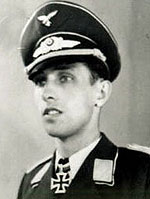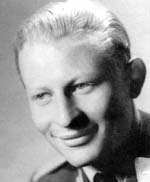
Stormbirds Rising
by Robert Taylor
"Stormbirds Rising captures a scene during the final weeks of the war as Leutnant Hermann Buchner, by now one of the most famous jet Aces and recipient of the coveted Knight’s Cross, joins his fellow pilots of III./JG7 as they climb to intercept a large formation of American bombers having just left their base at Parchim. Below them the tranquillity of the meandering River Havel, flowing gracefully through the countryside west of Berlin, is in stark contrast to the deadly encounters that will soon take place overhead. |
| Special Presentation | Conservation matted to include an additional six signatures of Luftwaffe pilots who flew the Me262 |
| SOLD |
| This four signature 'Collectors' edition print is presented in a triple-mat conservation mount, and includes the signatures of six additional Luftwaffe pilots who flew the Me262 in combat. The pilots represented scored a combined total of 830 aerial victories. Also included in the mount is a replica Luftwaffe pilot's badge. Overall size: 27⅝" x 34¾" Shipping is free within the continental United States. Note: This item is not available for shipping outside the U.S.A. |
| The signatures | ||
| Oberst Hermann Buchner - 58 victories | Oblt. Wolfgang Wollenweber | |
| Maj. Erich Rudorffer - 222 victories | Leutnant Jorg Czypionka - 2 victories | |
| Gen. Adolf Galland - 104 victories (matted) | Gen. Johannes Steinhoff - 176 victories (matted) |
| Oblt. Walter Schuck - 206 victories (matted) | Maj. Hans-Ekkehard Bob - 60 victories (matted) |
| Leutnant Gottfried Fährmann - 2 victories (matted) | Oberfeldwebel Hans Kirn (matted) |
 Adolf Galland Adolf Galland Adolf “Dolfo” Galland joined the Luftwaffe in February 1934, and in 1937 volunteered for service with the Condor Legion in Spain
where he flew 280 combat sorties. In September 1939 he took part in the invasion of Poland
flying 50 ground attack missions. Galland was posted to JG 27 and by the end of the French
campaign he had accumulated 14 victories. On 1 November 1940, Galland was promoted to Oberstleutnant and given command of JG 26.
On 21 June 1941, Galland was shot down, by the Polish ace Boleslaw Drobinski of 303 Sqn,
RAF, and baled out wounded. Galland had, by now, been ordered by Hitler and Göring not to fly
combat missions. However, he disregarded these orders and continued to rack up aerial victories.
On 22 November 1941, Galland was named General der
Jagdflieger. Late in the war he was given command of JV 44 which he led until 26 April
1945 gaining up to seven victories flying the |
 Johannes Steinhoff Johannes SteinhoffOne of JG52s most famous Aces, 'Macky' Steinhoff was a veteran of the Battle of Britain and fought on the Eastern Front where he became Kommandeur II./JG52. In March 1943 he was posted to North Africa to command JG77, and in December 1944 helped form and become Kommodore of JG7, the first operational Me262 jet unit. |
 Walter Schuck Walter SchuckSchuck's first operational assignment was with JG3 in October 1940, when I. Gruppe
JG 3 was tasked to give top cover to Adolf Hitler en route to Belgium. Shuck's unit was moved to Esbjerg, Denmark on After leaving JG5, Schuck trained on the Me 262 and joined JG7 on 5 March 1945. On 24 March 1945 Schuck and another pilot engaged a Lockheed P-38 Lightning F-5 escorted by two P-51 fighters. In the resulting combat, Schuck shot down the two P-51 fighters and the P-38 was claimed by his wingman. He would go on to claim another six victories in the Me262 bringing his total score to 206. On 10 April 1945 Schuck’s Me262 was hit by a P-51 piloted by Lt. Joseph Anthony Peterburs of the 55th Fighter Squadron. Schuck bailed out, spraining both ankles upon landing and the war ended before he recovered. |
 Erich Rudorffer Erich RudorfferFlying Bf109s with JG2 he became a double Ace during the Battle of Britain, and in April 1942 took command of II./JG52 in North Africa. In July 1943 he commanded II./JG54 in Russia where he secured his fearsome reputation, achieving more multiple victories than any other Lufwaffe pilot. This included five victories in four minutes on his first mission in Russia, 8 RAF aircraft in 32 minutes in December 1943, and 7 airvraft in 20 minutes a few days later. In January 1945 he returned to the west as Kommandeur of I./JG7 where he flew the new Me262 and became one of the most prominent jet Aces with 12 aerial victories. He ended the war as one of the Luftwaffe's most iconic fighter pilots , having been shot down 16 times in 1,000 combat missions and was the seventh highest scoring Ace in history with a total of 222 victories. |
 Hans-Ekkehard Bob Hans-Ekkehard BobJoining the Luftwaffe in 1936, Bob flew during the French campaign and the Battle of Britain. In October 1940 he was appointed Staffelkapitän of 9./JG 54. Later, he participated in the Balkan campaign, where he recorded his 20th and 21st victories. On 23 June 1941, he recorded his first victory in Russian airspace. During this combat, his Bf 109 was hit by return fire, resulting in a forced landing behind enemy lines. He evaded capture and returned to his unit two days later. Between 13 July and 30 October 1941, Bob made three more emergency landings behind enemy lines, but in each case returned to his unit. On 17 April 1943, Bob recorded his 57th victory; the ramming of a Boeing B-17 near Bremen. He bailed out and survived the crash without injury. On 1 August, Bob was promoted to the rank of Major and was appointed Gruppenkommandeur of IV./JG 54. He returned to the Eastern Front but by May 1944, he was back at the Western Front as Gruppenkommandeur of II./JG3. In August, he was transferred to Erprobungskommando 262 where he trained on the Messerschmitt Me 262 and was selected as one of the aces to fly as a member of JV 44, led by Adolf Galland. Hans-Ekkehard Bob flew approximately 700 combat missions and claimed 60 victories. He recorded 37 victories over the Eastern front. |
 Gottfried Fährmann Gottfried FährmannSteinhoff’s long standing wingman and Adjutant at JG77 in Italy. One of the original members of JV44, Fährmann joined the unit to continue as Steinhoff’s wingman, he scored one victory in the Me262 and survived being shot down by a P-51. He was alongside Steinhoff when he crashed. |
 Hans Kirn Hans KirnBorn August 8th, 1920 in Lindau, Germany. Joined the National Socialist Flying Corps NSFK on April 1st, 1939. Kirn started his basic military and flight training on October 14th, 1939 and graduated from Flugzeugführerschule Magdeburg on September 30th, 1940. Posted to Flugzeugführerschule Prague Rusin, then on to Blindflugschule (instrument flight training school) Strassburg until December 1941. |
 Hermann Buchner Hermann BuchnerJoining SG1 in March 1942 he originally flew Bf109s on the Eastern Front, taking part in ground attack missions, and his first victory came in September over a Soviet LaGG-3. By December he had flown 215 missions, one of which included a forced landing. In February 1943 he was hospitalized after his aircraft exploded at high altitudet, but he
was soon back in action with SG1 and then SG1, where he flow Fw190s in the Crimea and Romania, protecting the oil fields. In October 1944 he converted to the Me262, joining 9./JG7 where, on 26th November he shot down a P-38 Lightning, scoring the first jet victory in history. He became one of the foremost Me262 Aces with 12 jet victories, and finished the war with having flown over 630 combat missions and claiming 58 aerial victories, plus the destruction of 46 tanks and numerous other vehicles and anti-arcaft guns. |
 Wolfgang Wollenweber Wolfgang WollenweberVolunteering for the Luftwaffe in 1940 he completed training as a fighter pilot before joining JG5 'Eismeer' in early 1943. Based in Norway and equiped with Me110s he flew on escort operations and convoy patrols across the Arctic and North Atlantic as well as bombing missions against Murmansk and Russian airfields. Returning to Germany to take part in the Defence of the Reich, he first joined JG2 flying the Fw190 in Western Europe before moving to JG1 to fly the Me163 Komet rocket-powered fighter, and finally converted to the jet powered Heinkel He162. Based in Parchim along with Buchner's9./JG7, he completed a further fourteen missions in this revolutionary but highly temperamental and often lethel fighter from April 1945 until the end of the war. |
 Jorg Czypionka Jorg CzypionkaVery few pilots flew the Me262 as a night-fighter, but Jorg Czypionka was one of them. He enlisted in the Luftwaffe in 1940 and after completing flight training spent several years as an instructor. |